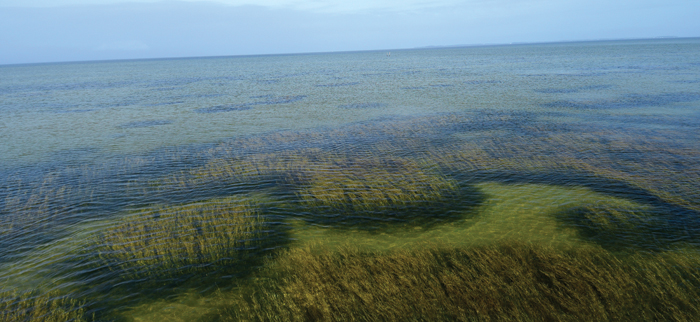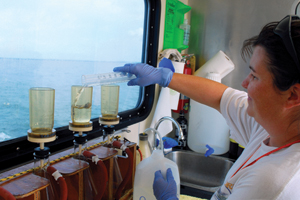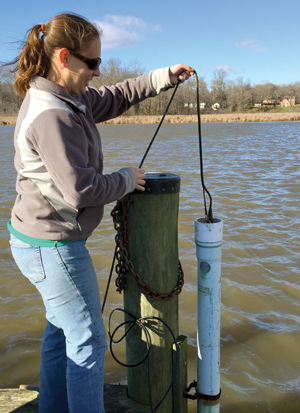The Chesapeake Clarity Comeback: Monitoring progress in bay health

Healthy grasses and clear water off Poplar Island; by Peter McGowan
A tide of good news on Chesapeake Bay health has been rolling in over the past couple of years. Anecdotal accounts, backed-up by scientific monitoring programs of the Maryland Department of Natural Resources and its partners, have observed promising improvements in water quality, aquatic habitats and the abundance of crabs and oysters.
The question on many minds remains: how?
Reducing pollutants
Since Chesapeake Bay water monitoring efforts began in 1985, the main focus for improving quality has been to reduce the amount of nutrients such as nitrogen, phosphorus and sediment entering the bay from a variety of sources—air pollution, runoff, septic systems and wastewater treatment plants. Reducing these pollutants produces clearer waters and improves growing conditions for underwater bay grasses, which serve as vital habitat for crabs, fish and other organisms. It also helps reduce the risk of algal blooms and, in turn, improves the levels of dissolved oxygen in the water needed to sustain life.
| Based on results from statewide tidal monitoring in 59 bay regions from 1999 to 2015, conditions met bay grass habitat goals or showed improvement in 76 percent of regions for total nitrogen, 83 percent for total phosphorus and 59 percent for total suspended solids. |
Beginning in the fall of 2015, natural resources scientists and citizens both observed exceptionally clear water, especially in Maryland’s lower region of the bay. Monitoring results showed that water clarity was slightly above average in most of the bay compared with 1985, but was well above average compared to the past five years. Other data show that clarity has been steadily improving over the past four years in some Eastern Shore tributaries. Improved clarity has carried over into 2016, with record water clarity observed around the Chesapeake Bay Bridge and lower Chester River.

Scientist collecting samples; by CBP
Better conditions
What contributed to this turn around? As with many environmental studies, the answers are complex but can likely be attributed to a combination of steady improvements in pollution reduction and cooperation from Mother Nature.
There has not been a major weather event in the watershed since Hurricane Irene and Tropical Storm Lee in 2011. Since that time, water flows entering the bay, as measured by the U.S. Geological Survey, have been mostly average or below average. Less flow equals less nutrients and sediments. Below average rainfall and drought years can often be a crystal ball into the future, mimicking what conditions would be if we fully achieve our pollution reduction goals.
Vegetation growth
Coupled with reduced flows and improved clarity, underwater bay grasses saw a marked improvement in 2015. The annual survey conducted by the Virginia Institute of Marine Science and funded by the states and federal partners found that throughout the bay, 91,621 acres of submerged aquatic vegetation were observed. This surpassed the 2017 Chesapeake Bay Watershed Agreement management goal of 90,000 acres and is nearly half the ultimate 185,000-acre goal.
Although 2016 results will not be available until next year, observations by biologists and others indicate that grasses are thriving. During a recent survey of the Susquehanna Flats grass beds, 11 species of grasses were identified in a small area. Such a diverse assemblage is a positive sign of the bay’s current health and resiliency.

Biologist deploys water quality monitor; department photo
Improved oxygen levels
Another positive sign is the reduction of low dissolved oxygen zones in Maryland’s portion of the bay. Each summer, the Department of Natural Resources, along with our Virginia counterparts, conduct twice monthly monitoring of dissolved oxygen concentrations. Areas with less than 2 mg/l of oxygen are termed hypoxic, while areas with less than 0.2 mg/l are known as anoxic. Generally, aquatic animals thrive in waters with 5 mg/l or greater.
Hypoxic conditions in June of this year were well below average, meaning that more suitable habitat was available for crabs and other aquatic animals to make their homes. This trend continued into early July, but a persistent excessive heat wave later in the month caused waters to hold and mix less oxygen, which pushed hypoxia volumes well above average. Conditions returned to average in August, despite record high temperatures throughout much of the watershed, which is a promising sign for bay health. Anoxia—the absence of oxygen—was not observed at all in 2016, and hasn’t been since the summer of 2014.
Aquatic life rebound
To many Marylanders, better environmental conditions, grasses and clarity boil down to perhaps the most important indicator of all: How are the crabs and oysters faring? Due to improved environmental conditions and prudent management, there is promising news here as well.
The 2016 Winter Crab Dredge Survey found that the blue crab population increased 35 percent to 553 million, with improvements seen in all age and sex categories. The adult male crab population doubled, and spawning female crabs nearly doubled to 194 millions crabs—well above the critical management threshold of 70 million, but slightly below the optimal target of 214 million. The abundance of juvenile crabs was also slightly above average.
Positive results were also seen from the 2015 Maryland Fall Oyster Survey. The number of spat, or baby oysters, tripled since 2014 and was 34 percent over the 31-year median. The biomass index, or overall amount of oysters, was the third highest in the 26-year record, only falling behind the previous two years. The mortality index, or number of dead oysters, remained below the 31-year average, continuing a positive 12-year trend resulting from lower pressure from disease. Furthermore, the dockside value of catches was $17.1 million, the highest reported since 1982.
These recent results are cause for optimism. Maryland is on track for meeting its nutrient and sediment reduction goals, but restoration efforts must and will continue. Environmental managers often equate restoring the bay to putting it on a diet. If that analogy holds true, we are off to a good start losing the ‘freshmen fifteen’ but we still have work to do to reach and maintain our target weight.
Maryland and the other watershed states have set aggressive goals to meet our target, and our monitoring will illustrate and guide our progress towards reaching our restoration goals.
Article by Mark Trice—Resource Assessment Service water quality informantics program chief. Renee Karrh, Brooke Landry, Catherine McCall, Bill Romano, Mitch Tarnowski and Kelly Webb contributed to this article.
Appears in Vol. 19, No. 4 of the Maryland Natural Resource magazine, fall 2016.

